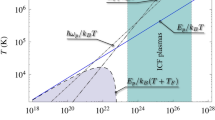Abstract
A previous model for treating electromagnetic nonlinear wave systems is examined in the context of wave mechanics. It is shown that nonlinear wave mechanics implies harmonic generation of new quasiparticle wave functions, which are absent in linear systems. The phenomenon is interpreted in terms of pair (and higher order ensembles) coherence of the interacting particles. The implications are far-reaching, and the present approach might contribute toward a common basis for diverse physical phenomena involving nonlinearity. An intimate relationship connecting coherence, nonlocal interaction, and nonlinearity has been previously noticed in the physics of superconductivity. It is shown here that all these ingredients are consistently contained in the present formalism. The present theory may contribute to elucidate a controversial theory proposed by Panarella, who claims to have measured high-energy photons due to high-intensity laser radiation, which cannot be predicted on the basis of linear quantum theory. Panarella explains the new phenomena by stipulating a nonlinear intensity-dependent photon energy. It is argued here that nonlinearity, manifested in the presence of high intensity, may give rise to high- and low-energy photons, the so-called “effective” and “tired” photons, respectively. However, the present explanation does not involve ad hoc assumptions regarding the foundations of quantum theory. In analogy with the electrodynamic model, the present theory leads to particulate self-focusing in high-density streams of particles. Since such particulate beams are currently under consideration in connection with fusion reactions, this might be of future interest.
Similar content being viewed by others
References
D. Censor,J. Plasma Phys. 16, 415 (1976).
D. Censor,Phys. Rev. A 16, 1673 (1977).
D. Censor and K. Suchy,Kleinheubacher Berichte 19, 617 (1976) (Proc. Conf. URSI Nat. Committee, Fed. Rep. Germany, October 1975).
D. Censor,J. Phys. A 10, 1781 (1977).
D. Censor,Phys. Rev. A 18, 2614 (1978).
J. L. Synge,Geometrical Mechanics and de Broglie Waves (Cambridge University Press, 1954).
D. Censor,Phys. Rev. D 19, 1108 (1979).
E. Panarella,Found. Phys. 4, 227 (1974).
E. Panarella,Found. Phys. 7, 405 (1977).
L. I. Schiff,Quantum Mechanics (McGraw-Hill, 1955).
M. Tinkham,Introduction to Superconductivity (McGraw-Hill, 1975).
V. L. Ginzburg,The Propagation of Electromagnetic Waves in Plasmas, 2nd ed. (Pergamon Press, 1970).
S. A. Akhamanov and R. V. Khokhlov,Problems of Nonlinear Optics (Gordon and Breach, 1972).
M. Schubert and B. Wilhelmi,Einführung in die nichtlineare Optik (Teubner, 1971), Vol. 1.
G. B. Whitham,Linear and Nonlinear Waves (Wiley, 1974).
G. A. Askaryan,Zh. Eksp. Teor. Fiz. 42, 1567 (1962) [Sov. Phys.—JETP 15, 1088 (1962)].
D. Censor, Wave packets and solitary waves—a dual approach. II: nonlinear systems, in preparation.
A. Messiah,Quantum Mechanics (North-Holland, 1970).
H. Poeverlein,Phys. Rev. 128, 956 (1962).
Author information
Authors and Affiliations
Additional information
On leave of absence from the Department of Electrical Engineering, Ben-Gurion University of the Negev, Beer Sheva, Israel.
Rights and permissions
About this article
Cite this article
Censor, D. Nonlinear wave mechanics and particulate self-focusing. Found Phys 10, 555–566 (1980). https://doi.org/10.1007/BF00715039
Received:
Issue Date:
DOI: https://doi.org/10.1007/BF00715039




